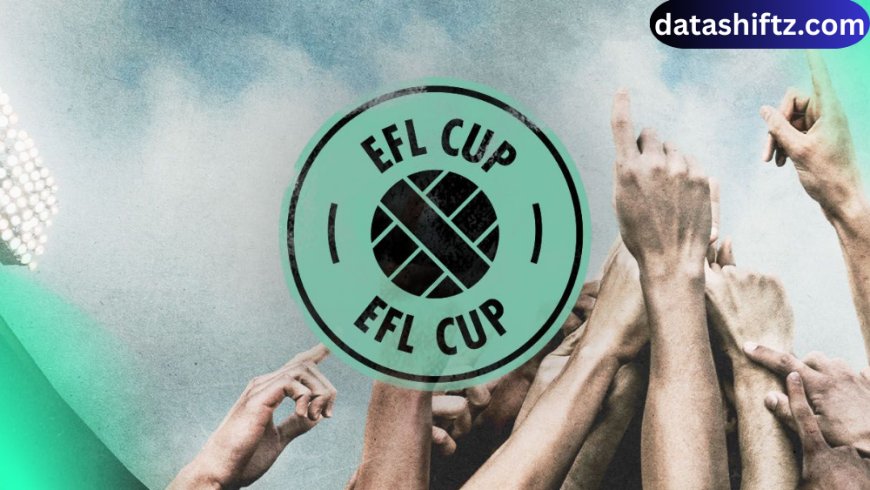EFL Cup: History, Format, and Modern Significance

Introduction
The EFL Cup, officially known as the Carabao Cup for sponsorship reasons, is one of the most exciting football competitions in English football. Unlike the prestigious FA Cup, which includes teams from all tiers of English football, the EFL Cup is specifically contested by the 92 clubs of the Premier League and the English Football League (EFL). Since its inception in 1960, the tournament has provided thrilling moments, underdog stories, and opportunities for silverware that are highly valued by both players and fans.
While some clubs see it as a chance to give younger players experience, for others it remains an important route to European qualification and domestic glory. This article dives deep into the history, structure, notable winners, and ongoing importance of the EFL Cup.
History of the EFL Cup
The EFL Cup was established in 1960 by then-Secretary of the Football League, Alan Hardaker. The idea was to create a midweek competition that could generate revenue and increase stadium attendance during the newly emerging era of floodlit football.
Key milestones in its history include:
-
The first final was held in 1961, won by Aston Villa.
-
Initially, the final was played over two legs, home and away, before moving to Wembley Stadium in 1967.
-
The competition has had different sponsors, leading to names like the Milk Cup, Coca-Cola Cup, Worthington Cup, Carling Cup, Capital One Cup, and now the Carabao Cup.
Format and Structure of the Competition
The EFL Cup is a knockout tournament played across several rounds:
-
First Round: Championship, League One, and League Two clubs compete.
-
Second Round: Premier League clubs not in European competitions enter.
-
Third Round: Premier League clubs in European competitions join.
-
Quarterfinals and Semifinals: Intense single-leg matches (semifinals were traditionally two legs but have been changed at times for scheduling).
-
Final: Played at Wembley Stadium, usually in late February.
The winner earns a spot in the UEFA Europa Conference League (or Europa League depending on rules and standings), adding further significance to the trophy.
EFL Cup Key Facts
| Category | Details |
|---|---|
| Established | 1960 |
| Current Sponsor | Carabao (officially Carabao Cup) |
| Participating Teams | 92 (20 Premier League + 72 EFL clubs) |
| Current Format | Knockout rounds + Wembley final |
| First Winner | Aston Villa (1961) |
| Most Successful Club | Liverpool (9 titles) |
| Prize | Trophy + UEFA European competition qualification |
| Final Venue | Wembley Stadium, London |
Notable Winners and Records
The EFL Cup has seen both dominant clubs and underdog champions.
-
Liverpool holds the record with 9 titles, highlighting their historical dominance.
-
Manchester City has been the standout team in the modern era, winning 6 times in 8 years (2014–2021).
-
Swansea City (2013) became the first non-English club to win the tournament.
-
Several lower-league clubs have had memorable runs, cementing the EFL Cup as a stage for surprises.
Reasons the EFL Cup is Important
-
European Qualification – Provides a pathway to UEFA competition.
-
First Major Trophy of the Season – The final is held in February, often shaping club momentum.
-
Opportunity for Young Players – Managers often use the cup to test academy prospects.
-
Chance for Silverware – A realistic shot for mid-table and lower Premier League clubs.
-
Revenue Generation – Extra games bring financial benefits, especially for smaller clubs.
-
Historic Rivalries – Famous matchups have added drama to the competition.
-
Fan Engagement – Provides midweek excitement for supporters.
-
Broadcast Exposure – Televised matches give clubs more visibility.
-
Balanced Format – Lower-league teams can face Premier League giants early.
-
Prestige – Despite being seen as secondary to the FA Cup, it remains a respected trophy.
Modern Significance of the EFL Cup
In the modern era, the EFL Cup plays a complex role:
-
For Big Clubs: It is often seen as a secondary competition but still valued as a chance to win silverware and keep squad players sharp. Clubs like Manchester City and Liverpool continue to dominate due to squad depth.
-
For Smaller Clubs: It represents one of the best chances to win a major domestic trophy and gain European exposure.
-
For Fans: It provides memorable nights, particularly when smaller clubs upset Premier League giants.
The financial rewards may not match those of the Premier League or Champions League, but the prestige of lifting a trophy at Wembley remains significant.
EFL Cup vs. FA Cup
Though both are knockout tournaments, they serve different purposes:
-
The FA Cup is older (since 1871) and includes clubs from all levels of English football, making it more prestigious.
-
The EFL Cup is younger and restricted to the top 92 clubs but offers faster progression to European football.
This distinction makes the EFL Cup a unique and complementary part of English football.
Conclusion
The EFL Cup may not always command the global attention of the Premier League or the FA Cup, but it holds a special place in English football. For top clubs, it is an opportunity to secure early-season silverware and strengthen squad depth. For smaller clubs, it represents a chance at glory, increased revenue, and even European competition.
With a history dating back to 1960, a tradition of thrilling finals at Wembley, and its role in shaping young talent, the EFL Cup continues to be an essential part of the football calendar. Whether seen as a stepping stone for elite teams or a golden opportunity for underdogs, the EFL Cup remains a beloved competition that highlights the drama and unpredictability of English football.






























